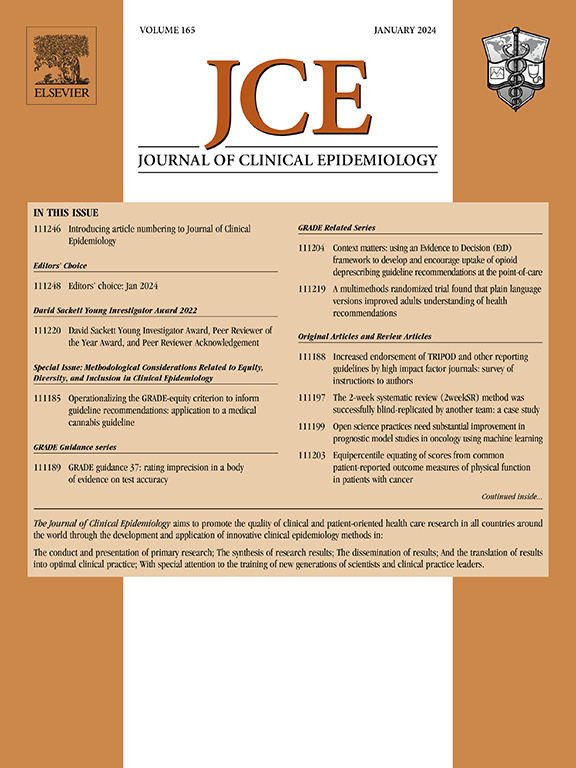High-impact trials with genetic and -omics information focus on cancer mutations, are industry-funded, and less transparent
IF 7.3
2区 医学
Q1 HEALTH CARE SCIENCES & SERVICES
引用次数: 0
Abstract
Objectives
To assess how genetics and -omics information is used in the most cited recent clinical trials and to evaluate industry involvement and transparency patterns.
Study Design and Setting
This is a meta-research evaluation using a previously constructed database of the 600 most cited clinical trials published from 2019 to 2022. Trials that utilized genetic or -omics characterization of participants in the trial design, analysis, and results were considered eligible.
Results
132 (22%) trials used genetic or -omics information, predominantly for detection of cancer mutations (n = 101). Utilization included eligibility criteria (n = 59), subgroup analysis (n = 82), and stratification factor in randomization (n = 14). Authors addressed the relevance in the conclusions in 82 studies (62%). 102 studies (77%) provided data availability statements and six had data already available. Most studies had industry funding (n = 111 [84.0%]). Oncology trials were more likely to be industry-funded (90.1% vs 64.5%, P = .001), to have industry-affiliated analysts (43.6% vs 22.6%, P = .036), and to favor industry-sponsored interventions (83.2% vs 58.1% P = .004). When compared to other trials, genetic and -omics trials were more likely to be funded by industry (84% vs 63.9%, P < .001) and tended to be less likely to have full protocols (P = .018) and statistical plans (P = .04) available.
Conclusion
Our study highlights the current underutilization of genetic and -omics technologies beyond testing for cancer mutations. Industry involvement in these trials appears to be more substantial and transparency is more limited, raising concerns about potential bias.
具有遗传和组学信息的高影响试验侧重于癌症突变,由行业资助,透明度较低。
目的:评估遗传学和组学信息如何在最近引用最多的临床试验中使用,并评估行业参与和透明度模式。研究设计和设置:这是一项元研究评估,使用先前构建的数据库,该数据库包含2019年至2022年发表的600项被引用最多的临床试验。在试验设计、分析和结果中利用参与者的遗传或组学特征的试验被认为是合格的。主要发现:132项(22%)试验使用遗传或组学信息,主要用于检测癌症突变(n=101)。应用包括资格标准(n=59)、亚组分析(n=82)和随机分层因素(n=14)。作者在82项研究(62%)的结论中提到了相关性。102项研究(77%)提供了数据可用性声明,6项研究已有数据可用。大多数研究有行业资助(n=111[84.0%])。肿瘤学试验更有可能是由行业资助的(90.1%对64.5%,p=0.001),有行业关联的分析师(43.6%对22.6%,p=0.036),以及支持行业赞助的干预措施(83.2%对58.1%,p=0.004)。与其他试验相比,基因和组学试验更有可能得到工业界的资助(84%对63.9%)。结论:我们的研究强调了目前基因和组学技术在癌症突变检测之外的利用不足。行业对这些试验的参与似乎更大,透明度更有限,引发了对潜在偏见的担忧。
本文章由计算机程序翻译,如有差异,请以英文原文为准。
求助全文
约1分钟内获得全文
求助全文
来源期刊

Journal of Clinical Epidemiology
医学-公共卫生、环境卫生与职业卫生
CiteScore
12.00
自引率
6.90%
发文量
320
审稿时长
44 days
期刊介绍:
The Journal of Clinical Epidemiology strives to enhance the quality of clinical and patient-oriented healthcare research by advancing and applying innovative methods in conducting, presenting, synthesizing, disseminating, and translating research results into optimal clinical practice. Special emphasis is placed on training new generations of scientists and clinical practice leaders.
 求助内容:
求助内容: 应助结果提醒方式:
应助结果提醒方式:


